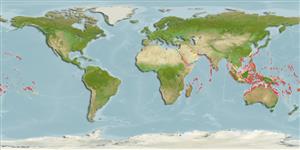Common names from other countries
>
Blenniiformes (Blennies) >
Blenniidae (Combtooth blennies) > Salariinae
Etymology: Exallias: Greek, exallias = strange, marvellous (Ref. 45335).
More on author: Kner.
Environment: milieu / climate zone / depth range / distribution range
Ecologia
marinhas associadas(os) a recifes; intervalo de profundidade 3 - 20 m (Ref. 9710), usually 3 - 8 m (Ref. 58302). Tropical; 30°N - 30°S
Indo-Pacific: Red Sea south to Sodwana Bay, South Africa (Ref. 4404) and east to the Hawaiian, Marquesan, and Society islands, north to the Ryukyu and Bonin islands, south to New Caledonia and Rapa.
Tamanho / Peso / Idade
Maturity: Lm ? range ? - ? cm
Max length : 14.5 cm TL macho/indeterminado; (Ref. 9710)
Descrição suscinta
Chaves de identificação | Morfologia | Morfometria
Espinhos dorsais (total) : 12; Raios dorsais (total) : 12 - 13; Espinhos anais: 2; Raios anais : 14 - 15. Numerous papillae on the upper lip, smaller and more closely spaced spots. Nuchal cirri: 30 - 36.
Adults occur on clear coastal reefs, often in bays and semi-exposed habitats (Ref. 48636). Found on the seaward edge of reefs, among corals like Acropora, Pocillopora, Seriatopora, Porites, and Millepora where they feed on coral tissues (Ref. 1602). Benthic (Ref. 58302). Males prepare nesting sites by overgrazing a patch of coral (Ref. 9710). Oviparous. Eggs are demersal and adhesive (Ref. 205), and are attached to the substrate via a filamentous, adhesive pad or pedestal (Ref. 94114). Larvae are planktonic, often found in shallow, coastal waters (Ref. 94114). Minimum depth reported taken from Ref. 30874.
Ciclo de vida ou comportamento de acasalamento
Maturities | Reprodução | Spawnings | Egg(s) | Fecundities | Larvas
Oviparous, distinct pairing (Ref. 205).
Myers, R.F., 1991. Micronesian reef fishes. Second Ed. Coral Graphics, Barrigada, Guam. 298 p. (Ref. 1602)
Status na Lista Vermelha da UICN (Ref. 130435)
CITES (Ref. 128078)
Not Evaluated
Ameaça para os humanos
Harmless
Uso pelos humanos
Pescarias: espécies comerciais; Aquário: Espécies comerciais
Ferramentas
Relatórios especiais
Baixar XML
Fontes da internet
Estimates based on models
Preferred temperature (Ref.
115969): 24.7 - 29.3, mean 28.3 (based on 3063 cells).
Índice de diversidade filogenética (Ref.
82804): PD
50 = 1.0000 [Uniqueness, from 0.5 = low to 2.0 = high].
Bayesian length-weight: a=0.01995 (0.00906 - 0.04395), b=3.01 (2.83 - 3.19), in cm Total Length, based on all LWR estimates for this body shape (Ref.
93245).
Nível Trófico (Ref.
69278): 4.3 ±0.4 se; based on diet studies.
Resiliência (Ref.
120179): Elevada, tempo mínimo de duplicação da população menor que 15 meses (Preliminary K or Fecundity.).
Fishing Vulnerability (Ref.
59153): Low vulnerability (10 of 100).
